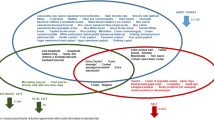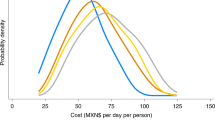Abstract
The impact of recent efforts to reduce the content of industrially produced trans fatty acids (TFA) in foods has not been systematically assessed in any country. Concerns exist that food manufacturers/restaurants may replace TFA with saturated fat acids (SFA), rather than cis unsaturated fats, or increase the total fat content. We present findings from a national systematic assessment of grocery and restaurant foods likely to contain TFA in Canada in 2005–2007. Of the total of 221 assessed products, 92 (42%) contained TFA (⩾5% of fatty acids) on initial assessment. Of an unselected sample assessed more than once, 72% were reformulated during 2005–2007: mean±s.d. TFA levels decreased from 26±13 to 2±4%. Following reformulation, one product had similar TFA+SFA content; all others had decreased TFA+SFA and increased cis unsaturated fat content. The total fat content was generally unaffected. The findings suggest that manufacturers/restaurants generally take advantage of costs and efforts of reformulation to not only reduce TFA but also increase the content of cis unsaturated fats.
This is a preview of subscription content, access via your institution
Access options
Subscribe to this journal
Receive 12 print issues and online access
$259.00 per year
only $21.58 per issue
Buy this article
- Purchase on Springer Link
- Instant access to full article PDF
Prices may be subject to local taxes which are calculated during checkout

Similar content being viewed by others
References
AOAC Official Method 996.06 (2001). Fat (total, saturated, and unsaturated) in foods, hydrolytic extraction gas chromatographic method. In: Horwitz W (ed). Official Methods of Analysis of AOAC International 18th edn. AOAC International: Urbana, IL.
Eckel RH, Borra S, Lichtenstein AH, Yin-Piazza SY (2007). Understanding the complexity of trans fatty acid reduction in the American diet: American Heart Association Trans Fat Conference 2006: report of the Trans Fat Conference Planning Group. Circulation 115, 2231–2246.
Health Canada (2005). Government response to the interim recommendations of the trans fat task force. Accessed at http://www.hc-sc.gc.ca/fn-an/nutrition/gras-trans-fats/government_response_reponse_gouvernement_e.html: 20 September 2005.
Health Canada (2007). Food & nutrition: trans fat monitoring program. Accessed at http://www.hc-sc.gc.ca/fn-an/nutrition/gras-trans-fats/tfa-age_tc-tm_e.html: 2 January 2008.
Leth T, Jensen HG, Mikkelsen AA, Bysted A (2006). The effect of the regulation on trans fatty acid content in Danish food. Atheroscler Suppl 7, 53–56.
Mozaffarian D, Katan MB, Ascherio A, Stampfer MJ, Willett WC (2006). Trans fatty acids and cardiovascular disease. N Engl J Med 354, 1601–1613.
New York City Department of Health and Mental Hygiene (2007). Healthy heart—avoid trans fat. Accessed at http://www.nyc.gov/html/doh/html/cardio/cardio-transfat.shtml: 26 January 2008.
Ratnayake WMN, C Gagnon C, Dumais L, Lillycrop W, Wong L, Meleta M et al. (2007). Trans fatty acid content of Canadian margarines prior to mandatory trans fat labelling. J Am Oil Chem Soc 84, 817–825.
U.S. Food and Drug Administration (2005). FDA acts to provide better information to consumers on trans fats. Accessed at http://www.fda.gov/oc/initiatives/transfat/: 12 August 2005.
Acknowledgements
We thank William Lillycrop, Keri Kwong, Lynn Wong, Mary Meleta (Health Canada, Ontario Region, Toronto, Ontario), Gary P Neumann, Thomas Krakalovitch, Adeline Rahardja, Veronica Roscoe (Health Canada, Manitoba and Saskatchewan Region, Winnipeg, Manitoba) and Claude Ganon (Health Canada, Ottawa, Ontario) for analysis of the food samples, and Sara Farnwoth (Health Canada, Ottawa, Ontario) for compiling the fatty acid data. This work was supported by a grant from the National Heart, Lung, and Blood Institute, National Institutes of Health (K08-HL-075628).
Author information
Authors and Affiliations
Corresponding author
Additional information
Contributors: WMNR and MRL'Abbe contributed to the design of the experiment, collection of data, and critical revision and approval of the final manuscript. DM contributed to the conception of the manuscript, analysis of data, and drafting, critical revision and approval of the final manuscript.
Rights and permissions
About this article
Cite this article
Ratnayake, W., L'Abbe, M. & Mozaffarian, D. Nationwide product reformulations to reduce trans fatty acids in Canada: when trans fat goes out, what goes in?. Eur J Clin Nutr 63, 808–811 (2009). https://doi.org/10.1038/ejcn.2008.39
Received:
Revised:
Accepted:
Published:
Issue Date:
DOI: https://doi.org/10.1038/ejcn.2008.39
Keywords
This article is cited by
-
Does the ban on trans-fats improve public health? In search of the optimal policy response
Journal of Regulatory Economics (2019)
-
The need for multisectoral food chain approaches to reduce trans fat consumption in India
BMC Public Health (2015)
-
A survey of the reformulation of Australian child-oriented food products
BMC Public Health (2013)
-
Reformulating partially hydrogenated vegetable oils to maximise health gains in India: is it feasible and will it meet consumer demand?
BMC Public Health (2013)
-
Ejecting trans fat from New York City restaurants
Nature Reviews Endocrinology (2012)



